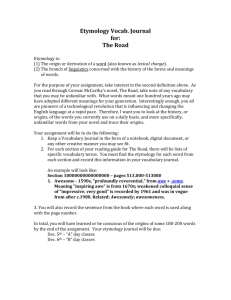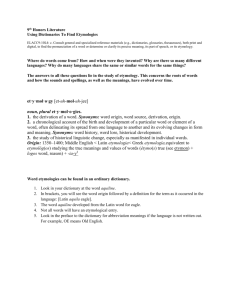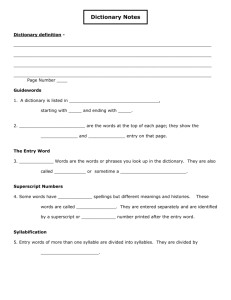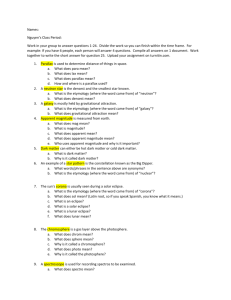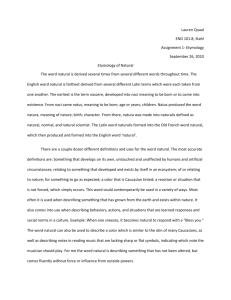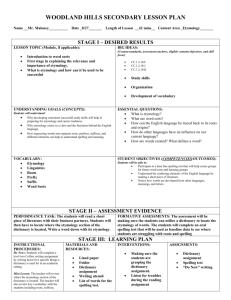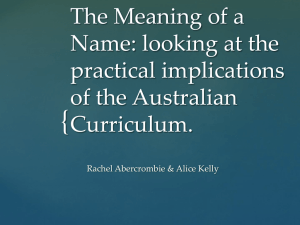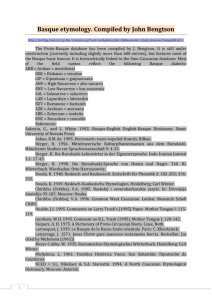Recall Information: Stated Concepts I
advertisement
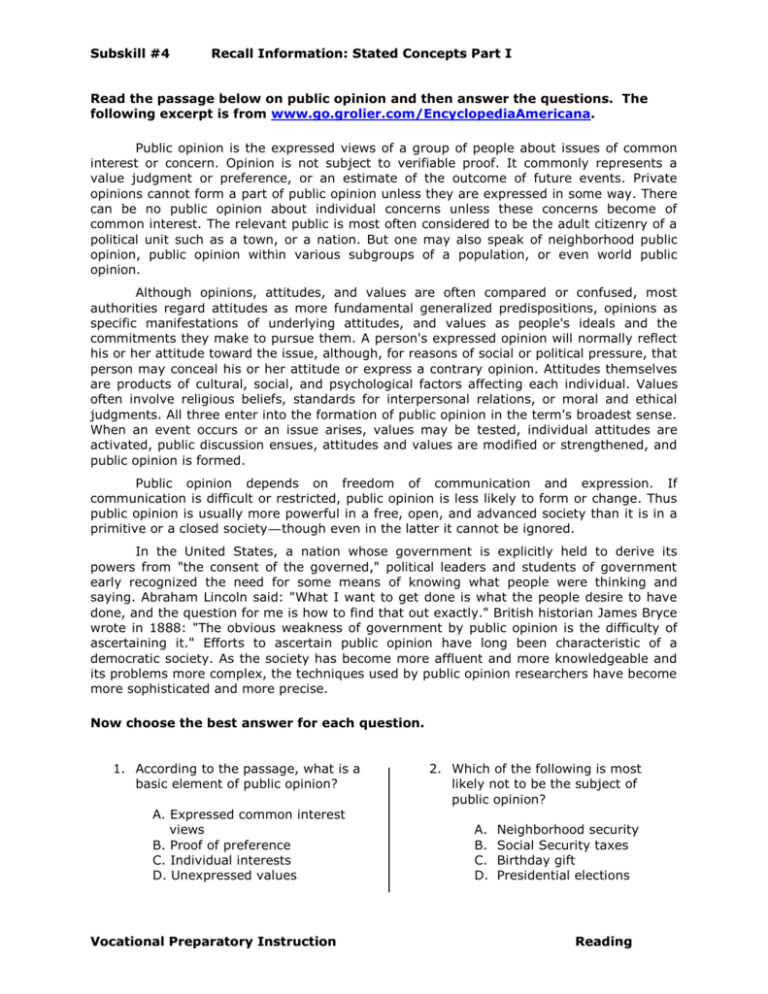
Subskill #4 Recall Information: Stated Concepts Part I Read the passage below on public opinion and then answer the questions. The following excerpt is from www.go.grolier.com/EncyclopediaAmericana. Public opinion is the expressed views of a group of people about issues of common interest or concern. Opinion is not subject to verifiable proof. It commonly represents a value judgment or preference, or an estimate of the outcome of future events. Private opinions cannot form a part of public opinion unless they are expressed in some way. There can be no public opinion about individual concerns unless these concerns become of common interest. The relevant public is most often considered to be the adult citizenry of a political unit such as a town, or a nation. But one may also speak of neighborhood public opinion, public opinion within various subgroups of a population, or even world public opinion. Although opinions, attitudes, and values are often compared or confused, most authorities regard attitudes as more fundamental generalized predispositions, opinions as specific manifestations of underlying attitudes, and values as people's ideals and the commitments they make to pursue them. A person's expressed opinion will normally reflect his or her attitude toward the issue, although, for reasons of social or political pressure, that person may conceal his or her attitude or express a contrary opinion. Attitudes themselves are products of cultural, social, and psychological factors affecting each individual. Values often involve religious beliefs, standards for interpersonal relations, or moral and ethical judgments. All three enter into the formation of public opinion in the term's broadest sense. When an event occurs or an issue arises, values may be tested, individual attitudes are activated, public discussion ensues, attitudes and values are modified or strengthened, and public opinion is formed. Public opinion depends on freedom of communication and expression. If communication is difficult or restricted, public opinion is less likely to form or change. Thus public opinion is usually more powerful in a free, open, and advanced society than it is in a primitive or a closed society though even in the latter it cannot be ignored. In the United States, a nation whose government is explicitly held to derive its powers from "the consent of the governed," political leaders and students of government early recognized the need for some means of knowing what people were thinking and saying. Abraham Lincoln said: "What I want to get done is what the people desire to have done, and the question for me is how to find that out exactly." British historian James Bryce wrote in 1888: "The obvious weakness of government by public opinion is the difficulty of ascertaining it." Efforts to ascertain public opinion have long been characteristic of a democratic society. As the society has become more affluent and more knowledgeable and its problems more complex, the techniques used by public opinion researchers have become more sophisticated and more precise. Now choose the best answer for each question. 1. According to the passage, what is a basic element of public opinion? A. Expressed common interest views B. Proof of preference C. Individual interests D. Unexpressed values Vocational Preparatory Instruction 2. Which of the following is most likely not to be the subject of public opinion? A. B. C. D. Neighborhood security Social Security taxes Birthday gift Presidential elections Reading Subskill #4 Recall Information: Stated Concepts Part I 3. According to the passage, which of the following are needed for public opinion to be formed? A. Attitudes, opinions, and values B. Attitudes, concerns, and interests C. Religious beliefs, interpersonal relations, and ethical judgments D. Values, ideals, and commitments 4. In which type of government is public opinion more likely to be expressed? A. B. C. D. Oligarchy Dictatorship Communist Regime Democracy Read the passage below on the heart and then answer the questions. This excerpt was taken from www.go.grolier.com/EncyclopediaAmericana. In ancient times the beating heart was regarded as the very soul or spirit of a person and the core or center of the body. Certain words pertaining to the spirit, such as cordial and courage, are derived from cor, the Latin word for the heart. St. Valentine's day, which was celebrated as early as the 7th century, has as its emblem the human heart, although it is distorted in shape to resemble that of a diseased heart in which both sides are of equal size. Today, the heart is known to be the organ that pumps blood through the body, and the site of the soul or spirit has been transferred metaphorically to the brain, where it is said to reside with thinking, learning, and other "higher" faculties. It was obvious even to early societies that the pulsating heart was a pump distributing to the brain and all other parts of the body important substances, including nourishment from the gastrointestinal tract and liver and a vital spirit from the lungs. However, it was not until the Middle Ages and later that the details of circulation were discovered. First, the circulation of the blood through the lungs was worked out by Ibn alNafis, Andreas Vesalius, Michael Servetus, and Realdo Colombo. Next, the general body, or systemic, circulation was worked out by Fabricius ab Aquapendente, Andrea Cesalpino, and William Harvey. In later years it was found that certain accessory aids help the heart in maintaining an optimal circulation of the blood. Undoubtedly, the most important aid is that of the large muscles of the legs which, on contracting, squeeze the veins in the legs. Since these veins are supplied with valves that prevent the blood from gravitating to the feet, the blood is actually pumped upward when the veins are squeezed, relieving the heart of about one third of its work when the legs are used actively, as in cycling, running, swimming, or jogging. A second important aid is that of the elasticity of the aorta, the large artery that receives a jet of blood from the heart every time the heart contracts and converts these jets into a much smoother, more efficient flow of blood. When hardening of the aorta wall develops as a result of arteriosclerosis in which fat, cholesterol, calcium, and other materials build up on the artery wall the advantage of the natural elasticity is lost. Preventive measures developed by good health habits in youth undoubtedly delay the onset of arteriosclerosis and lead to a longer and healthier life. A third aid is a freely moving diaphragm that is unimpeded by abdominal fat. When the diaphragm moves up and down, as it does in breathing, the chest cavity, or thorax, Vocational Preparatory Instruction Reading Subskill #4 Recall Information: Stated Concepts Part I becomes a suction pump that helps to bring blood up from below as well as to bring air into the lungs. A fourth aid is the arterial system's ability to adjust to the changing demands of different organs. After a meal, for example, during the process of active digestion, the blood supply to the gastrointestinal tract has greater priority than that to the skeletal muscles, which are at rest. During exercise, the situation is normally reversed, with the skeletal muscles receiving priority over the gastrointestinal tract. Now choose the best answer for each question. 5. According to the excerpt, what delays the onset of arteriosclerosis? A. A freely moving diaphragm B. Blood supply to the gastrointestinal tract C. Good health habits in youth D. Large muscles of the legs 6. Which is not an aid that helps the heart in maintaining an optimal circulation of the blood? A. The skeletal muscles that receive priority over the gastrointestinal tract B. A free moving diaphragm C. The elasticity of the aorta D. The contractions of the large muscles of the legs 7. According to the excerpt, which of the following would have priority to the blood supply when you are exercising? A. The diaphragm B. The skeletal muscles C. The gastrointestinal tract D. The aorta Read the passage below on etymology and then answer the questions. This excerpt was taken from www.go.grolier.com/EncyclopediaAmericana. Etymology is the branch of philology that traces the forms and often the meanings of words as far back as possible. We also speak of "the etymology of a word," meaning what the science of etymology has to say about its history. An example of this meaning is the etymology of "etymology" itself. It is from the Greek etymon plus -logia," an account of the true, or original, meaning of a word." Finally, at one time "etymology" was often used to mean the earliest or an early form of a word, though today "etymon" is more commonly so used. Thus the Old English (Anglo-Saxon) etymon of Modern English "cow" is c , and the Indo-European etymon of both is *gw u-. The asterisk before gw u- means that the form is a hypothetically reconstructed probability, not an actually recorded form. The hyphen means that various suffixes might follow, indicating various cases Vocational Preparatory Instruction Reading Subskill #4 Recall Information: Stated Concepts Part I and numbers. Old English is the "father" of Modern English, just as Old French is the "father" of Modern French, and Indo-European is the "great-grandfather" of both. Since etymology is the history of changes in words, it would not need to exist and indeed could not exist if languages did not change. But they do. They change everywhere and always and in many ways, but in three that are especially relevant here. Every language tends (1) to borrow words from other languages and hence to discard native words or narrow their meanings. And even without borrowing, every language tends (2) to change the forms of its words and (3) to change their meanings. Now choose the best answer for each question. 8. Which of the following best explains why etymology is relevant today? A. Etymology tracks the adaptations of language. B. Etymology discards words and narrows their meanings. C. Etymology causes languages to change. D. Etymology prevents languages from changing. 10. Which of these would be true if languages remained constant? A. Everyone would speak Modern English. B. The science of etymology would be relevant to the study of languages. C. There would be no need for the science of etymology. D. Modern French would be the “father” of Old French. 9. According to the excerpt, what do languages have in common? A. Languages never change the forms and meanings of words. B. Languages only discard native words or narrow their meanings. C. Languages remain constant and true to their earliest forms. D. Languages borrow from other languages and change the forms and meanings of words. Vocational Preparatory Instruction Reading Subskill #4 Recall Information: Stated Concepts Part I Answer Key 1. A 2. C 3. A 4. D 5. C 6. B 7. B 8. A 9. C 10. C Vocational Preparatory Instruction Reading
